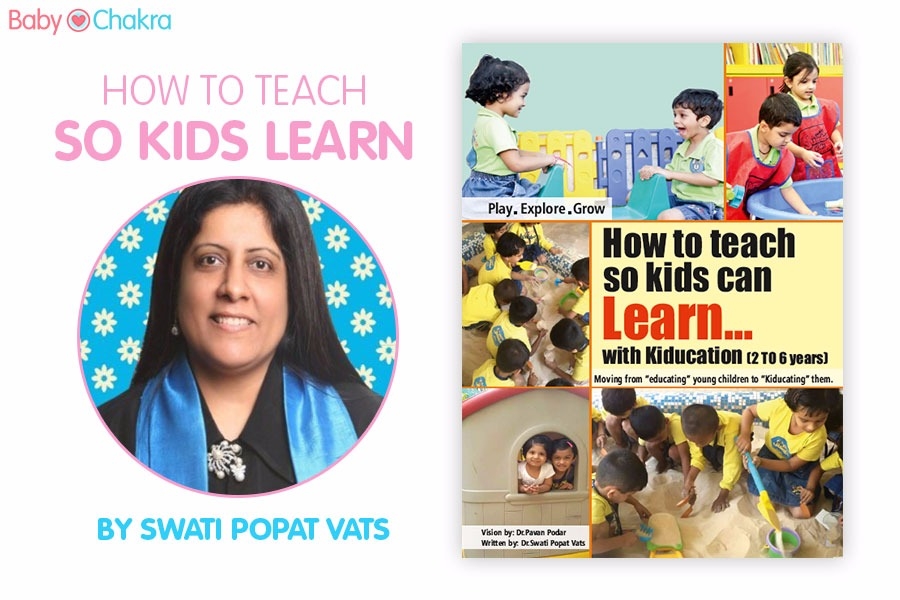
How To Teach So Kids Can Learn by Swati Popat Vats: Book Review
11 Oct 2017 | 4 min Read
Babychakra
Author | 1369 Articles
Educating parents to help them help kids learn better!
When every parent in today’s times is struggling to be the best parent they can be, there was a serious dearth of an Indian book on how to teach young children. More so, for teachers of pre-primary children, who often lack adequate training facilities and resources in India.
What is the book about?
The book How To Teach So Kids Can Learn authored by Dr Swati Popat Vats, President, Early Childhood Association, is a much-needed book for educators and parents alike. The book introduces a concept called ‘Kiducation’, which is about educating children in alignment with their developmental needs. It starts with the history of early childhood care and education (ECCE), the pioneers in India and the world, leading philosophies and the National Policy for ECCE in India as laid down by the Women and Child Development Ministry.
It is a very comprehensive book which explains in-depth why it is important to teach a child in the early years and how to align that with their brain development. It covers the entire gamut of questions that a parent or educator may have – is it necessary to send a child to preschool, how to deal with separation anxiety, child abuse, how to assess readiness of a preschooler, and all elements of a quality early childhood curriculum.
Elements of learning and teaching like – language and communication, emotional development, social development, nurturing emotional development in young children, behavior management, reading and writing readiness, numeracy skills, nature and art education, learning through play and by doing, are well addressed in this book.
What we loved about the book
Dr Vats lays emphasis on sensitive issues like – whether children should be interviewed for school admissions, gender awareness, how to help children deal with terrorist attacks, if it is appropriate to hug or kiss children without their consent and how should they be taught to deal with it.
At places, it also elucidates the concept with specific examples.

Try and use encouragement more than praise when talking to children about their art work. “Wow, that’s a nice picture”, is not very sincere. This will make children use art only to get praise and not as a self-expression.
Instead use these sentences –
“Do you want to tell me about your colourful picture?”
“I like the way you have used red, yellow and brown colours. Are they your favourite colours?”
“The boy looks happy; can you tell me what is making him happy?”
“Who is behind that tree? Is he hiding from someone?”
What could have been done differently
We thought that the book could have more examples of activities in some curricular areas. For example – it lays out that four-year-olds begin to develop one-to-one correspondence, estimate quantities randomly and so on.
It would have been great if there were examples to demonstrate these through activities and assess children on those. What it also perhaps misses to address- are red flags/ developmental delays at each age group and measures for early interventions.
Our recommendation:
The book is definitely a must-have for school teachers, school owners and facilitators and activity class teachers. For parents, it is a good starting guide to understand their child’s development, select the right school and simply open up to a lot of scientific wisdom and best practices to adopt with young children at home and school.
Also read: How to – Keep Calm And Tame Your Toddler’s Tantrums
Explore the entire collection of articles: Parenting Gyan
If you are reading this article on our website and have an Android phone, please download our APP here for a more personalised experience based on you lifestage.
Read More On Baby #earlylearning #toddlerlearning #education #drswatipopatvats
#earlylearning #toddlerlearning #education #drswatipopatvats
A


Related Topics for you
Suggestions offered by doctors on BabyChakra are of advisory nature i.e., for educational and informational purposes only. Content posted on, created for, or compiled by BabyChakra is not intended or designed to replace your doctor's independent judgment about any symptom, condition, or the appropriateness or risks of a procedure or treatment for a given person.
